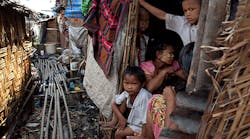Every year, environmental risks – such as indoor and outdoor air pollution, secondhand smoke, unsafe water, lack of sanitation and inadequate hygiene – take the lives of 1.7 million children under age 5, say two new reports from the World Health Organization (WHO).
The first report, “Inheriting a Sustainable World: Atlas on Children’s Health and the Environment,” reveals that a large portion of the most common causes of death among children ages 1 month to 5 years – diarrhea, malaria and pneumonia – are preventable by interventions known to reduce environmental risks, such as access to safe water and clean cooking fuels.
“A polluted environment is a deadly one – particularly for young children,” says WHO Director-General Dr. Margaret Chan. “Their developing organs and immune systems, and smaller bodies and airways, make them especially vulnerable to dirty air and water.”
Harmful exposures can start in the mother’s womb and increase the risk of premature birth. Additionally, when infants and pre-schoolers are exposed to indoor and outdoor air pollution and secondhand smoke, they have an increased risk of pneumonia in childhood, and a lifelong increased risk of chronic respiratory diseases, such as asthma. Exposure to air pollution may also increase their lifelong risk of heart disease, stroke and cancer.
Top 5 Causes of Early Childhood Death Linked to the Environment
A companion report, “Don't Pollute my Future! The Impact of the Environment on Children's Health,” provides a comprehensive overview of the environment’s impact on children’s health, illustrating the scale of the challenge. Every year:
- 570,000 children under 5 years die from respiratory infections such as pneumonia that are attributable to indoor and outdoor air pollution, and secondhand smoke.
- 361,000 children under age 5 die due to diarrhea as a result of poor access to clean water, sanitation and hygiene.
- 270,000 children die during their first month of life from conditions including prematurity, that could be prevented through access to clean water, sanitation and hygiene in health facilities as well as by reducing air pollution.
- 200,000 deaths of children under age 5 from malaria could be prevented through environmental actions such as reducing breeding sites of mosquitoes or covering drinking-water storage.
- 200,000 children under age 5 die from unintentional injuries attributable to the environment, such as poisoning, falls and drowning.
Ongoing and Emerging Environmental Threats to Children’s Health
“A polluted environment results in a heavy toll on the health of our children,” says Dr. Maria Neira, director of the Department of Public Health, Environmental and Social Determinants of Health for WHO. “Investing in the removal of environmental risks to health, such as improving water quality or using cleaner fuels, will result in massive health benefits.”
For example, emerging environmental hazards, such as electronic and electrical waste (such as old mobile phones) that is improperly recycled, expose children to toxins that can lead to reduced intelligence, attention deficits, lung damage and cancer. The generation of electronic and electrical waste is forecasted to increase by 19 percent between 2014 and 2018, to 50 million metric tons by 2018.
With climate change, temperatures and levels of carbon dioxide are rising, favoring pollen growth, which is associated with increased rates of asthma in children. Worldwide, 11–14 percent of children ages 5 years and older currently report asthma symptoms and an estimated 44 percent of these are related to environmental exposures. Air pollution, second-hand tobacco smoke and indoor mold and dampness make asthma more severe in children.
In households without access to basic services, such as safe water and sanitation, or that are smoky due to the use of unclean fuels such as coal or dung for cooking and heating, children are at an increased risk of diarrhea and pneumonia.
Children also are exposed to harmful chemicals through food, water, air and products around them. Chemicals, such as fluoride, lead and mercury pesticides, persistent organic pollutants and others in manufactured goods eventually find their way into the food chain. And, while leaded gasoline has been phased out almost entirely in all countries, lead still is widespread in paints, affecting brain development.
Making All Places Safe for Children
Reducing air pollution inside and outside households, improving safe water and sanitation and improving hygiene (including in health facilities where women give birth), protecting pregnant women from secondhand tobacco smoke and building safer environments, can prevent children’s deaths and diseases.
For example, multiple government sectors can work together to improve the following:
- Housing: Ensure clean fuel for heating and cooking, no mold or pests and remove unsafe building materials and lead paint.
- Schools: Provide safe sanitation and hygiene, free of noise, pollution and promote good nutrition.
- Health facilities: Ensure safe water, sanitation and hygiene and reliable electricity.
- Urban planning: Create more green spaces, safe walking and cycling paths.
- Transport: Reduce emissions and increase public transport.
- Agriculture: Reduce the use of hazardous pesticides and no child labor.
- Industry: Manage hazardous waste and reduce the use of harmful chemicals.
- Health sector: Monitor health outcomes and educate about environmental health effects and prevention.
Under the Sustainable Development Goals (SDGs), countries are working on a set of targets to guide interventions for children’s environmental health, as well as to end preventable deaths of newborns and children under five by 2030. In addition to SDG 3, which aims to ensure healthy lives and promote well-being for all, other SDGs work to improve water, sanitation and hygiene, transition to clean energy to reduce air pollution and reverse climate change – all of which will have an impact on children’s health.

